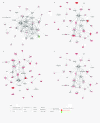Understanding mechanisms of vitiligo development in Smyth line of chickens by transcriptomic microarray analysis of evolving autoimmune lesions
- PMID: 22500953
- PMCID: PMC3353230
- DOI: 10.1186/1471-2172-13-18
Understanding mechanisms of vitiligo development in Smyth line of chickens by transcriptomic microarray analysis of evolving autoimmune lesions
Abstract
Background: The Smyth line (SL) of chicken is an excellent avian model for human autoimmune vitiligo. The etiology of vitiligo is complicated and far from clear. In order to better understand critical components leading to vitiligo development, cDNA microarray technology was used to compare gene expression profiles in the target tissue (the growing feather) of SL chickens at different vitiligo (SLV) states.
Results: Compared to the reference sample, which was from Brown line chickens (the parental control), 395, 522, 524 and 526 out of the 44 k genes were differentially expressed (DE) (P ≤ 0.05) in feather samples collected from SL chickens that never developed SLV (NV), from SLV chickens prior to SLV onset (EV), during active loss of pigmentation (AV), and after complete loss of melanocytes (CV). Comparisons of gene expression levels within SL samples (NV, EV, AV and CV) revealed 206 DE genes, which could be categorized into immune system-, melanocyte-, stress-, and apoptosis-related genes based on the biological functions of their corresponding proteins. The autoimmune nature of SLV was supported by predominant presence of immune system related DE genes and their remarkably elevated expression in AV samples compared to NV, EV and/or CV samples. Melanocyte loss was confirmed by decreased expression of genes for melanocyte related proteins in AV and CV samples compared to NV and EV samples. In addition, SLV development was also accompanied by altered expression of genes associated with disturbed redox status and apoptosis. Ingenuity Pathway Analysis of DE genes provided functional interpretations involving but not limited to innate and adaptive immune response, oxidative stress and cell death.
Conclusions: The microarray results provided comprehensive information at the transcriptome level supporting the multifactorial etiology of vitiligo, where together with apparent inflammatory/innate immune activity and oxidative stress, the adaptive immune response plays a predominant role in melanocyte loss.
Figures


References
-
- Erf GF. In: Vitiligo. Picardo M, Taieb A, editor. Heidelberg: Springer; 2010. Animal model; pp. 205–218.
Publication types
MeSH terms
LinkOut - more resources
Full Text Sources
Other Literature Sources
Medical

